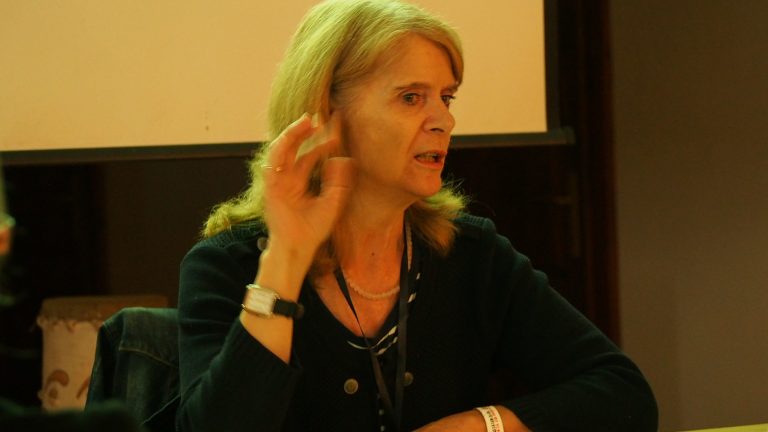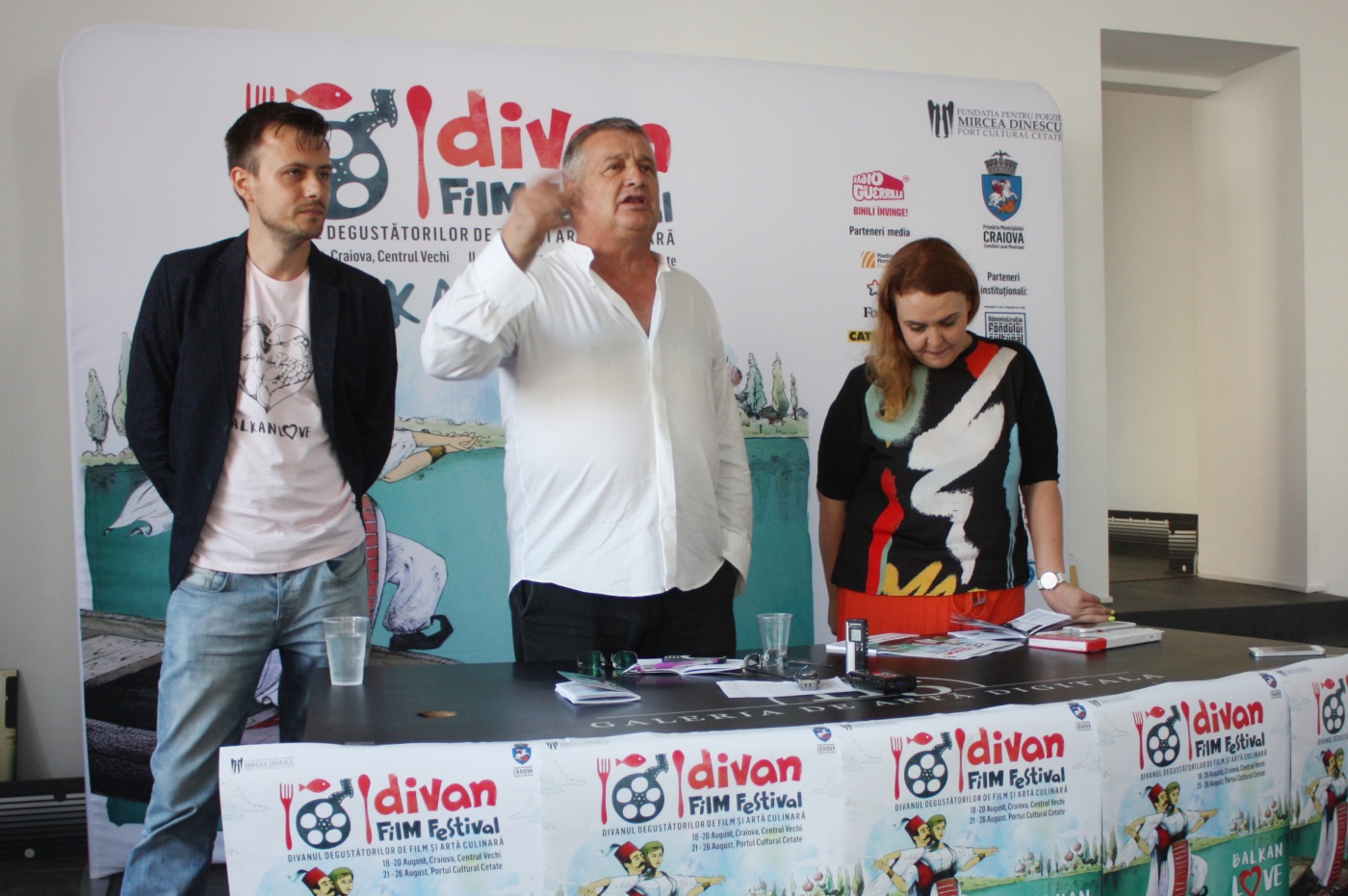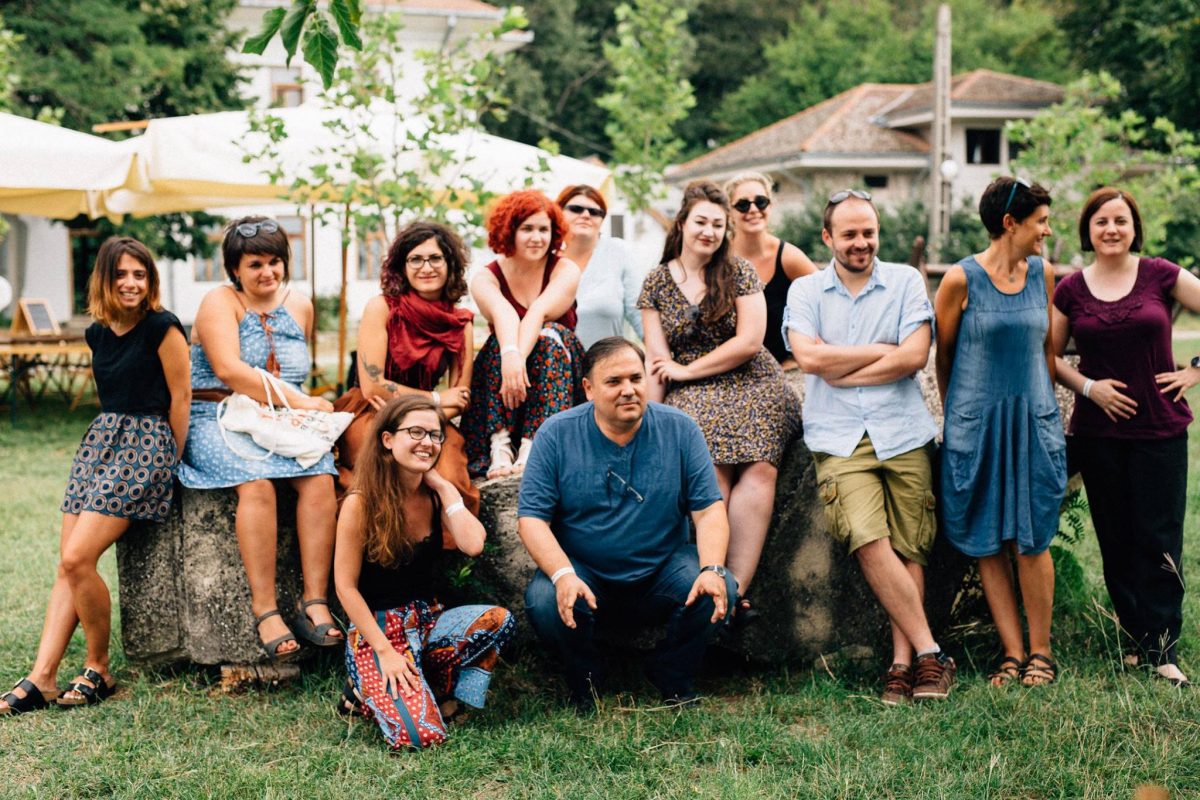The five or six day festival is in fact divided in two by a traditional cruise to the Danube Gorges. The guests embark in a bus up to the harbour Orșova and from there they make a scenic cruise upstream by boat through the narrow river that cuts the Carpathian Mountains and separates Romania from Serbia. In 2013 instead of the cruise we made a trip by bus to Bulgaria in order to see the Belogradchik Fortress and rocks.
As Mircea Dinescu owns Galicea Mare winery which is not far away from Cetate sometimes we organize visits and tasting at the wine cellars.
We hosted several exhibitions of art. I shall mention only the caricature exhibition in 2013 “Romanians and Bulgarians in Schengen Space”.
In 2016 the Divan hosted "5C Project", a cinematic culture itinerary course dedicated to the formation of five young film critics. The program was co-organized by the Balkan Cultural Association (Romania), Adriapol (Albania), Balkanski Kulturen Krug (Croatia) and Altcine (Greece) with the support of the European Union Media Program. "The 5C Project" debuted in January in Athens when a jury selected the authors of the best film reviews of the Balkan Short Film Festival on line Altcine Action!. The project was born from my idea that festivals give awards to the filmmakers but never to the critics. By awarding the best of them who were able to write in English we could achieve two goals: to better promote the festival by good reviews and to encourage young critics to write. Galina Maksimovic (Serbia), Rhianon Wain (UK), Andrei Şendrea (Romania), Özge Özdüzen (Turkey) and Mariana Hristova (Bulgaria) were selected. The program continued in Belgrade and Split in May and ended in Tirana International Film Festival in October 2016.
Important Guests and Films
Among the most important filmmakers I can mention Serbian Slobodan Sijan (17), Greek directors Nikos Perakis and Fotos Lambrinos, Romanian directors
Lucian Pintilie,
Nae Caranfil and
Laurențiu Damian, Albanian director

Piro Milkani, Macedonian director Antonio Mitrikeski, producers like Bulgarian Martichka Bozhilova, Romanian
Oana Giurgiu,
Anca Puiu and
Cristian Comeagă, Romanian stars
Maia Morgenstern (18),
Dorotheea Petre (19) and
Florin Zamfirescu, as well as actors like Slovenian Mojca Fatur and Greek Andreas Konstantinou. We can add to these VIP guests also presidents of the national film centres Electra Venaki and Artan Minarolli, in Greece, respectively in Albania, Aleksandar Erdeljanović, director of the Serbian Cinematheque, film critics and scholars like Antonia Kovacheva, Aleksandar Yanakiev, Gergana Doncheva and Petar Kardjilov from Bulgaria, reputed Dina Iordanova from St.Andrews University in UK, Lydia Papadimitriou from John Moore University in Liverpool, Ana Grgić from Croatia, Ismet Arasan from Turkey, Sergey Lavrentiev from Russia, Nevena Daković and Aleksandra Milovanović from Serbia, Stefan Sidovski from Macedonia, Dan Fainaru from Israel, a regular contributor to Variety, Screen International and Jerusalem Post, Ivan Forgacs from Hungary,
Massimiliano Nardulli from Italy, alongside reputed Romanian film critics
Dana Duma,
Magda Mihăilescu,
Marilena Ilieșiu,
Angelo Mitchievici, Constantin Pârvulescu,
Mihai Fulger and
Valerian Sava. We should add also Bulgarian cartoonist Valentin Georgiev. In terms of countries of origin we had guests from 21 countries.
As for the movies we shall mention first some shorts awarded in Cannes:
The Sudden and Untimely Death of Colonel K.K./ Iznenadna i prerana smrt pukovnika K.K (1987, Yugoslavia, directed by Miloš Radović),
Marriage/ Jenitba (1985, Bulgaria, directed by Slav Bakalov and Rumen Petkov),
Silent/ Sessiz be deng (2012, Turkey, directed by Lokman Rezan Yeşilbaş) and
Barking Island/ Chienne d’histoire (2010, France- Turkey, directed by Serge Avedikian), in Berlinale:
Rabbitland (2013, Serbia, directed by Ana Nedeljkovic and Nikola Majdak), or Oscar-nominated:
Oktapodi (2007, France, directed by Julien Bocabeille, François- Xavier Chanioux, Olivier Delabarre, Thierry Marchand, Quentin Marmier and Emud Mokhberi). From the long feature films we should mention the European premiere of the film
The White Tiger/ Belyy Tigr (2012, Russia, directed by Karen Shakhnazarov),
Stone Years/ Petrinia hronia (1985, Greece, directed by Pantelis Voulgaris), winner of two special mentions in Venice,
The Road/ Yol (1982, Turkey- Switzerland- France, directed by Serif Gören and Yilmaz Güney), awarded with the Golden Palm in Cannes and nominated for the Golden Globe,
An Unforgettable Summer/ O vară de neuitat (1994, Romania- France, directed by Lucian Pintilie), nominated for the Golden Palm award,
Death in Sarajevo/ Smrt u Sarajevu (2016, France- Bosnia- Herzegovina, directed by Danis Tanović), winner of the Silver Bear (Grand Jury Prize) in Berlinale, as well as some box-office successes such as
The Priest's Children/ Svecenikova djeca (2013, Croatia- Serbia- Montenegro, directed by Vinko Bresan) or
Mission London/ Misia London (2010, Bulgaria- UK- Hungary- Macedonia- Sweden, directed by Dimitar Mitovski).
Funny Adventures
One of the funniest adventures we had ever had was in 2013. That year instead of making our traditional cruise at the Danube Gorges we made a trip by bus to Bulgaria at the marvellous Belogradchik rocks
(20). We were at the border checking when one of festival drivers called me on the phone. He was supposed to take from the airport the Greek director Nikos Perakis. He called and said that the director is together with his wife but they act strange. I asked my Greek friend Electra Venaki if Perakis had a wife or lover and she said no. At the same time a tourist agent from a luxury hotel called and told me that we took by mistake their guests, the head of the Greek police and his wife. Everybody in the bus was angry with me because I did not cease to talk on the phone instead of getting on the bus to leave. It was really difficult to explain hastily the confusion and solve the problem. I dictated the driver's phone to the travel agent, calm down the Greek filmmaker and make him leave with her car. The two cars met somewhere on the road near Bucharest and made an exchange of ‘prisoners’! The head of the Greek police and his wife had panicked when noticing that the driver was not heading to Bucharest. Finally I found out that confusion had occurred because both the film director and the chief of the Greek police were called “Nikos Perakis”!
Outcomes of the Festival?
Divan Film Festival has become not just another film festival in Romania but “one of the greatest small festivals in the world” as some of our foreign guests put it. Indeed, its popularity crossed the border so that even Bulgarian border guards know about us as we could see with our own eyes when we crossed the new bridge over the Danube between Calafat and Vidin.
Of course, it is hard to quantify the contribution of a festival to the education of filmgoers and filmmakers, or to a closer collaboration between filmmakers from the Balkan countries and beyond. However, the volumes that gathered in their pages in English and Romanian comparative studies of some scholars interested in the Balkan phenomenon revealed common places and other things not known by specialists from other countries. “Balkan cinema studies” seemed a few years ago something strange and exotic but now they have to be taken seriously into consideration. One the other hand I really hope that Dina Iordanova will consider Divan Film Festival in her next film festival studies, her latest object of study. Such a small festival can be sometimes as important as a missing link in the human evolution. Not least I have to mention that at the last two editions we even produced some co-production films made entirely in Cetate!
Some time ago, after the great economic crisis of the 1930s, tens of thousands of Romanians came into pilgrimage in a village near Cetate, at Maglavit. There, a shepherd who suddenly had become able to hold a religious speech told to the crowd that he had seen God while he was with his sheep. The Romanian Church did not recognize the miracle, but many peasants visited Maglavit in the hope that meeting with the man who spoke with God would change their lives. Now Cetate has become a must see in an area that seemed to have no tourist potential and the main attraction is the festival with its cinematic, gastronomic and musical surprises...
1. This article was commissioned by
BFA Journal and was written for the special issue dedicated to film festival studies.
2. In translation means “Gathering of Tasters of Film and Culinary Art”.
3. The name of the magazine comes from a famous careerist and demagogue politician, a character in the play
A Lost Letter (1884) by Romanian dramatist Ion Luca Caragiale.
4. Well-known translator from Russian. We have been colleagues during high school.
5. In 2008 I published my PhD. paper under the title “Orient Express. Romanian and Balkan Cinema”. Meanwhile, alongside Dina Iordanova and Nevena Daković I have become one of the founders of Balkan cinema studies.
6. With an area of 468.000 square kilometres is the twentieth part of Europe and having a population of almost 80 million people it represents the ninth part of Europe's population.
7. We can compare the Balkan Peninsula with Southeast Asia or Indochina with its mosaic of seven countries.
8. “Haidouk” is a Balkan word for “outlaw” “Bào kè” (暴客), especially a good one of Robin Hood type, taking from the rich and giving to the poor.
9. Nasreddin Hodja is a Turkish wise man, remembered for his funny stories and anecdotes. In Uzbekistan and China is known as Afanti (阿凡提).
10. Here “partisans” refer to paramilitary forces engaged behind the front line against German and Italian army during WW2 in Yugoslavia, Greece and Albania.
11. in Homer's
Iliad.
12. The main character in the famous film
Alexis Zorbas (1964, Greece- USA, directed by Michael Cacoyannis).
13. It is about an ironic allusion at the formation of the Romanian people (the Roman army leaving the territory of the Dacians), to the slow transition between communism and the market society (eternal transition), and the name of the hero in Cristi Puiu's film
The Death of Mr. Lazarescu (2005): Dante (alluding to his poem about his journey to hell), Remus (the legendary founder of the city of Rome, a very used ethnonym for Romanians, which reminds of their Latin blood) and Lazarescu (a Romanian family form for Lazar, the man in the Bible resurrected from the dead).
14. CNC is a similar institution as in France like a small ministry of cinema, which is in charge with funding film production and other activities related to cinema.
15. It is an institution similar to British Council or Goethe Institute, which promotes Romanian culture especially abroad.
16. UCIN is one of the five unions of the filmmakers in Romania, the oldest (1964) and biggest one.
17. His film
Who's Singin' Over There?/ Ko to tamo peva (1980) was voted as the best Serbian film ever.
18. Winner of the European film awards in 1993 and of a special mention in Venice in 1995, starring in films by Márta Mészáros, Theodoros Angelopoulos, Mel Gibson etc.
19. Winner of the award Un certain regard for the best actress in Cannes (2006).
20. They are fabulous, as remind of the Great Canyon in Arizona.
 Reads the Newspaper was forbidden in Romania but published in Amsterdam. After the 1989 revolution he founded a weekly magazine of humour and satire called Cațavencu (3). The magazine became famous and feared by politicians. Dinescu proved to be also a skilled businessman after selling it very well. After a few years without his humour and skills of his collaborators the magazine fell, so he took it over again very cheap and rebuilt its prestige. Now as a rich “landlord” in Cetate, as he jokingly called himself, Mircea Dinescu found a new passion: culinary art. He began to cook recipes old and traditional, as well as with amazing innovations. He opened a restaurant in Bucharest and hosts a famous TV show where he invites celebrities to cook and chat inspired by the flavours of the kitchen.
Reads the Newspaper was forbidden in Romania but published in Amsterdam. After the 1989 revolution he founded a weekly magazine of humour and satire called Cațavencu (3). The magazine became famous and feared by politicians. Dinescu proved to be also a skilled businessman after selling it very well. After a few years without his humour and skills of his collaborators the magazine fell, so he took it over again very cheap and rebuilt its prestige. Now as a rich “landlord” in Cetate, as he jokingly called himself, Mircea Dinescu found a new passion: culinary art. He began to cook recipes old and traditional, as well as with amazing innovations. He opened a restaurant in Bucharest and hosts a famous TV show where he invites celebrities to cook and chat inspired by the flavours of the kitchen. .jpg) Tanović, the filmmakers belonging to the “Romanian New Wave” or Turkish directors like Nuri Bilge Ceylan or Semih Kaplanoglu have strengthened the fame of Balkan cinema. Today, "Balkan Cinema" is a trademark for a distinct, valuable cinema that conquers foreign audiences. One can even say that some Balkan filmmakers have succeeded to transform the dramatic experience of the region's war into perennial audio-visual works. Of course, usually it is about “ethno cinema” as in Kusturica's films including a shocking mixture of violence and humour but Romanian directors like Cristi Puiu and Cristian Mungiu have become undisputed world masters of minimalist realism. Half a century ago “Scandinavian cinema” was in fashion, now it is the time of the Balkan filmmakers, until recently underestimated.
Tanović, the filmmakers belonging to the “Romanian New Wave” or Turkish directors like Nuri Bilge Ceylan or Semih Kaplanoglu have strengthened the fame of Balkan cinema. Today, "Balkan Cinema" is a trademark for a distinct, valuable cinema that conquers foreign audiences. One can even say that some Balkan filmmakers have succeeded to transform the dramatic experience of the region's war into perennial audio-visual works. Of course, usually it is about “ethno cinema” as in Kusturica's films including a shocking mixture of violence and humour but Romanian directors like Cristi Puiu and Cristian Mungiu have become undisputed world masters of minimalist realism. Half a century ago “Scandinavian cinema” was in fashion, now it is the time of the Balkan filmmakers, until recently underestimated. Divan Film Festival is organized by the “Poetry Foundation Mircea Dinescu”. The morning and afternoon screenings take place in a hall of 100 seats (“The River Station”), which sometimes is used as a hall for receptions and concerts. The evening screenings are in open air for approximately 200 spectators. The first two editions were held at the beginning of September but he had to move the festival ahead for a few days, at the end of August, because in the evening in September it gets cold and windy, especially on the Danube. The screenings are made usually from DVD and BluRay discs with English and Romanian subtitles. The English subtitles are usually on the film, while the Romanian subtitles show up separately below the images, directly on the screen. Usually we made three screenings a day, although we tried four screenings but it was too tiring for the audience. We have to take into account that besides films screenings the festival hosts also concerts, cooking shows, book promotions, exhibitions and the scientific conference.
Divan Film Festival is organized by the “Poetry Foundation Mircea Dinescu”. The morning and afternoon screenings take place in a hall of 100 seats (“The River Station”), which sometimes is used as a hall for receptions and concerts. The evening screenings are in open air for approximately 200 spectators. The first two editions were held at the beginning of September but he had to move the festival ahead for a few days, at the end of August, because in the evening in September it gets cold and windy, especially on the Danube. The screenings are made usually from DVD and BluRay discs with English and Romanian subtitles. The English subtitles are usually on the film, while the Romanian subtitles show up separately below the images, directly on the screen. Usually we made three screenings a day, although we tried four screenings but it was too tiring for the audience. We have to take into account that besides films screenings the festival hosts also concerts, cooking shows, book promotions, exhibitions and the scientific conference. 

 Piro Milkani, Macedonian director Antonio Mitrikeski, producers like Bulgarian Martichka Bozhilova, Romanian Oana Giurgiu, Anca Puiu and Cristian Comeagă, Romanian stars Maia Morgenstern (18), Dorotheea Petre (19) and Florin Zamfirescu, as well as actors like Slovenian Mojca Fatur and Greek Andreas Konstantinou. We can add to these VIP guests also presidents of the national film centres Electra Venaki and Artan Minarolli, in Greece, respectively in Albania, Aleksandar Erdeljanović, director of the Serbian Cinematheque, film critics and scholars like Antonia Kovacheva, Aleksandar Yanakiev, Gergana Doncheva and Petar Kardjilov from Bulgaria, reputed Dina Iordanova from St.Andrews University in UK, Lydia Papadimitriou from John Moore University in Liverpool, Ana Grgić from Croatia, Ismet Arasan from Turkey, Sergey Lavrentiev from Russia, Nevena Daković and Aleksandra Milovanović from Serbia, Stefan Sidovski from Macedonia, Dan Fainaru from Israel, a regular contributor to Variety, Screen International and Jerusalem Post, Ivan Forgacs from Hungary, Massimiliano Nardulli from Italy, alongside reputed Romanian film critics Dana Duma, Magda Mihăilescu, Marilena Ilieșiu, Angelo Mitchievici, Constantin Pârvulescu, Mihai Fulger and Valerian Sava. We should add also Bulgarian cartoonist Valentin Georgiev. In terms of countries of origin we had guests from 21 countries.
Piro Milkani, Macedonian director Antonio Mitrikeski, producers like Bulgarian Martichka Bozhilova, Romanian Oana Giurgiu, Anca Puiu and Cristian Comeagă, Romanian stars Maia Morgenstern (18), Dorotheea Petre (19) and Florin Zamfirescu, as well as actors like Slovenian Mojca Fatur and Greek Andreas Konstantinou. We can add to these VIP guests also presidents of the national film centres Electra Venaki and Artan Minarolli, in Greece, respectively in Albania, Aleksandar Erdeljanović, director of the Serbian Cinematheque, film critics and scholars like Antonia Kovacheva, Aleksandar Yanakiev, Gergana Doncheva and Petar Kardjilov from Bulgaria, reputed Dina Iordanova from St.Andrews University in UK, Lydia Papadimitriou from John Moore University in Liverpool, Ana Grgić from Croatia, Ismet Arasan from Turkey, Sergey Lavrentiev from Russia, Nevena Daković and Aleksandra Milovanović from Serbia, Stefan Sidovski from Macedonia, Dan Fainaru from Israel, a regular contributor to Variety, Screen International and Jerusalem Post, Ivan Forgacs from Hungary, Massimiliano Nardulli from Italy, alongside reputed Romanian film critics Dana Duma, Magda Mihăilescu, Marilena Ilieșiu, Angelo Mitchievici, Constantin Pârvulescu, Mihai Fulger and Valerian Sava. We should add also Bulgarian cartoonist Valentin Georgiev. In terms of countries of origin we had guests from 21 countries.